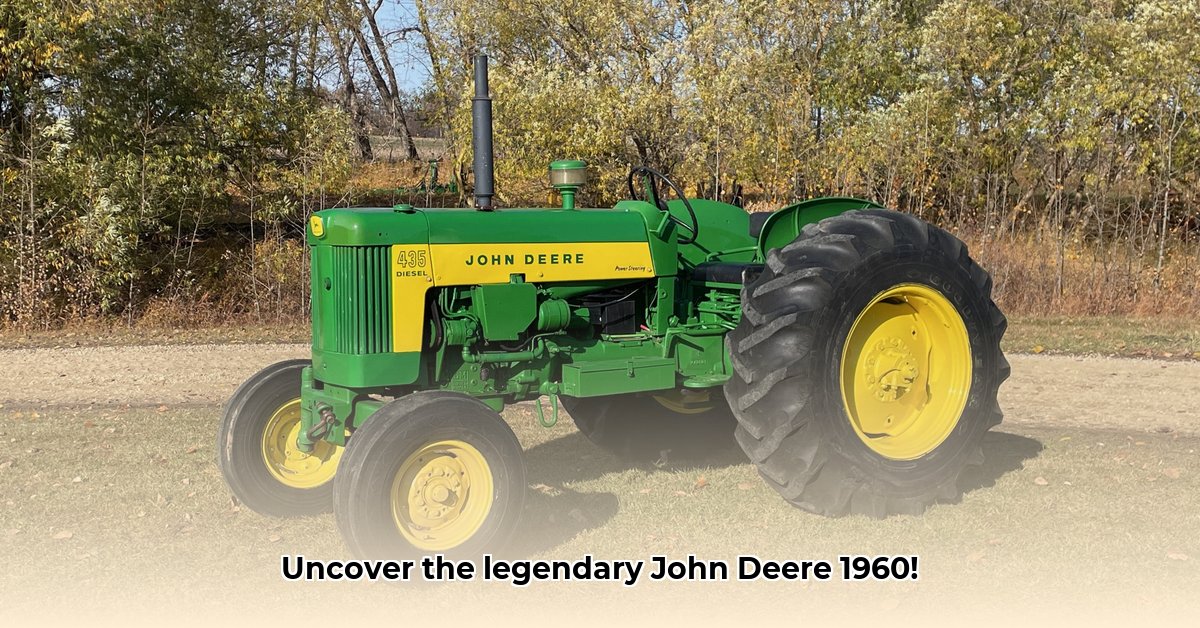
(Note: The John Deere Model 60 was produced from 1952-1956, not 1960.)
Picture this: post-war America, farms expanding rapidly, and a desperate need for machines that could keep pace with the burgeoning demand for food. Enter the John Deere 60 – a tractor that wasn't just powerful, but a symbol of a transformative era in American agriculture. This wasn't some flashy, newfangled gadget; it was a reliable workhorse that helped farmers achieve greater output, faster. For more on vintage John Deere tractors, see this great resource: [John Deere Tractors](https://john-deere-vintage-tractors.pages.dev). This in-depth article explores what made the Model 60 so special, examining its design, its various versions, its impact on farming practices, and its enduring appeal to collectors today.
The Post-War Agricultural Boom and the John Deere 60’s Rise
The post-World War II era witnessed a dramatic shift in American agriculture. Government support, coupled with technological advancements, spurred farmers to adopt larger and more efficient machinery. This fueled a massive demand for improved tractors. The John Deere 60, produced from 1952 to 1956, emerged as a key player in this agricultural revolution. Its production run perfectly encapsulates this period of rapid technological progress. Farmers demanded machines capable of handling larger fields and heavier workloads—and the John Deere 60 delivered. Did its success surprise Deere & Company? Almost certainly not, given their market research and understanding of the changing agricultural landscape. The company had its finger on the pulse of the American farmer's needs.
Under the Hood: Powering the Post-War Farm
The John Deere 60 wasn't just any tractor; it was a symbol of progress. John Deere offered several versions to cater to diverse farming requirements. At the core of each model was a reliable two-cylinder engine, available with gasoline, all-fuel, or liquid propane (LP) gas options. Horsepower varied slightly depending on the fuel and specific model, generally ranging from 30 to 40 horsepower—a substantial increase compared to earlier tractor models. The 6-speed transmission lacked synchronization (requiring careful matching of engine speed during shifting), but it provided ample gear options for most farm tasks. Crucially, it was exceptionally reliable and hardy.
Later models, introduced around 1954, incorporated power steering—a game-changing feature that dramatically simplified operation, reduced operator fatigue, and significantly boosted overall efficiency. Imagine the difference—no more wrestling with the steering wheel, especially during long, arduous days in the fields! This marked a considerable step forward in tractor design at the time.
Model Variations: A Tractor for Every Task
Recognizing the diverse needs of farmers, John Deere cleverly offered several variants of the Model 60. The 60, 60S, 60S6, 60-O, and 60H each possessed unique attributes, demonstrating Deere's keen understanding of the varied landscape of American agriculture.
| Model | Key Features |
|---|---|
| 60 | The foundational model of the series. |
| 60S | Built upon the 60 with enhanced features and improved performance. |
| 60S6 | Further refinements, showcasing ongoing advancements for the time. |
| 60-O | Designed for specialized operations, likely with dedicated implements. |
| 60H | A heavy-duty model suitable for demanding tasks. |
This diversity ensured that a John Deere 60 could effectively tackle a wide range of agricultural tasks, from planting delicate crops to pulling heavy equipment. Its adaptability cemented its status as a keystone of post-war farming. How did this versatility impact the overall success of the Model 60? Its adaptability played a major role in its widespread adoption across diverse farming operations.
The John Deere 60's Enduring Influence
The John Deere 60's impact transcended mere increases in horsepower and efficiency. It fundamentally changed farming practices, accelerating the shift toward larger-scale, more productive operations. Farmers could cultivate larger fields more quickly and with greater ease. It wasn't just a machine; it was an integral part of a larger narrative of agricultural innovation. Its design elements notably influenced subsequent tractor designs, showcasing its lasting legacy on the entire industry. That impact continues to resonate even today.
A Collector's Dream: A Piece of Farm History
Today, well-preserved John Deere 60 tractors are highly sought-after by collectors. Their historical significance, combined with their relative scarcity, makes them prized possessions for enthusiasts. Restoring one offers a deeply rewarding way to preserve a piece of agricultural history. However, it's important to note that value significantly depends on the tractor's condition. A meticulously restored model can command a far higher price than one needing extensive repair. What drives the collector's market for this classic tractor? The combination of historical significance and the challenge of restoration makes it a highly desirable collector's item.
Conclusion: A Legacy of Innovation
The John Deere 60, produced from 1952 to 1956, remains an iconic symbol of agricultural innovation. Its design, versatility, and popularity accurately reflected the evolving needs of American farmers during the post-war boom. It stands as a testament to enduring engineering principles and its impact on modern agriculture is undeniable.